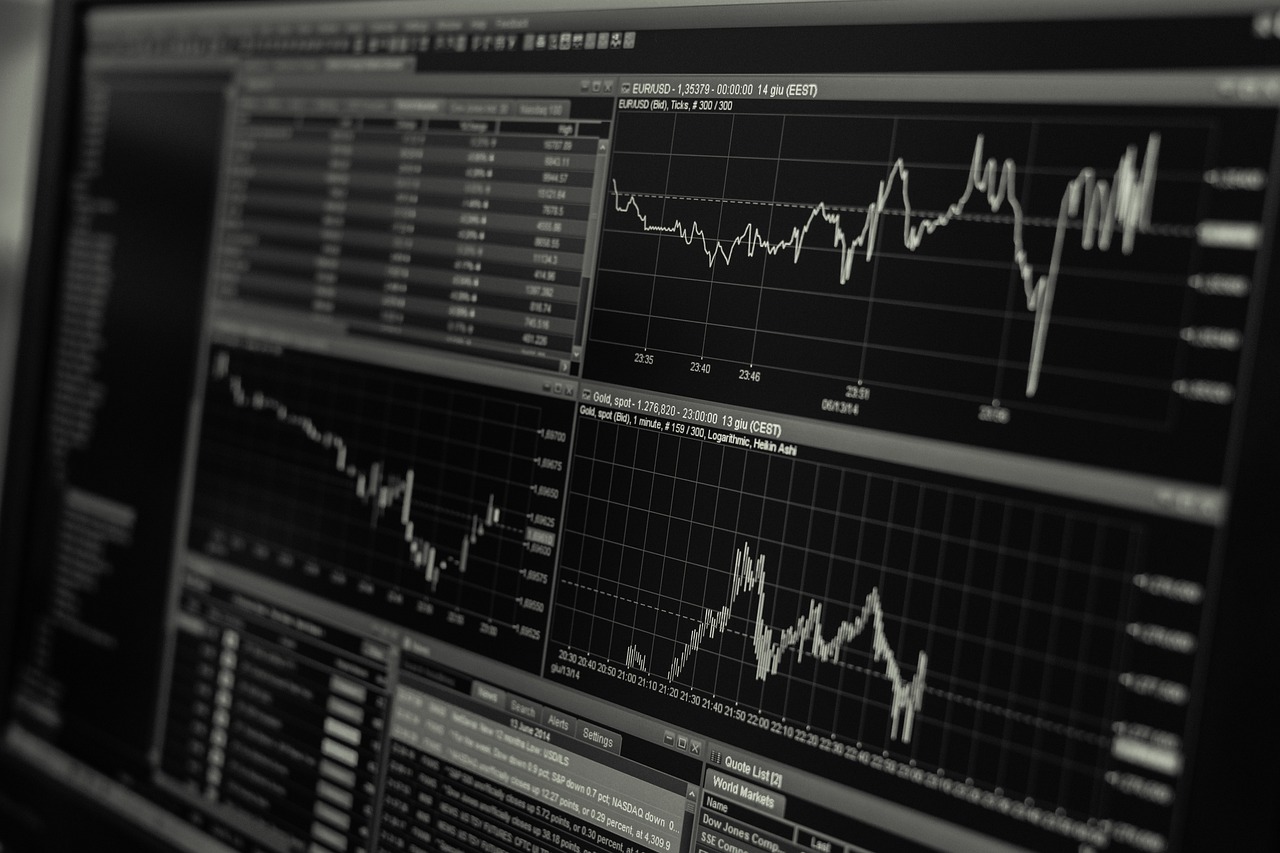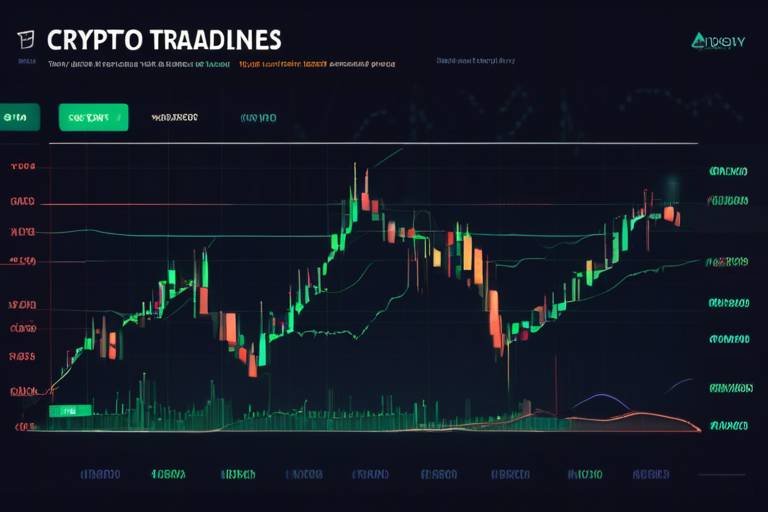The Benefits of Using a Trading Journal in Crypto Trading
In the fast-paced and often unpredictable world of cryptocurrency trading, having a solid strategy can make all the difference. One powerful tool that traders can utilize to enhance their trading experience is a trading journal. Think of it as your personal roadmap, guiding you through the tumultuous market while helping you make informed decisions. But what exactly are the benefits of maintaining a trading journal? Let’s dive into the various advantages that can significantly boost your trading performance, discipline, and overall decision-making.
One of the most significant benefits of keeping a trading journal is the ability to monitor your performance over time. By documenting each trade, including entry and exit points, reasons for the trade, and outcomes, you can gain valuable insights into your trading habits. This practice allows you to identify successful strategies and pinpoint areas that need improvement. For instance, you might discover that you consistently perform well during specific market conditions or that certain trading strategies yield better results. By analyzing this data, you can refine your approach, leading to better trading outcomes.
Discipline is crucial in trading, and a trading journal fosters this trait by encouraging you to stick to your strategies. It’s all too easy to get swept away by the emotional highs and lows of trading, but a journal acts as a reminder of your planned strategies. When you document your trades, you create a system that helps you adhere to your rules, avoiding impulsive decisions that can lead to significant losses. This systematic approach not only stabilizes your trading but also builds a sense of accountability.
Documenting trades helps maintain consistency by ensuring that you stick to your planned strategies rather than deviating due to market fluctuations or emotional impulses. A well-maintained journal serves as a reference point, reminding you of the strategies that have worked in the past. This consistency is essential for long-term success in trading.
Another advantage of keeping a trading journal is the ability to set specific, measurable goals. By outlining what you want to achieve, whether it’s a certain profit target or a specific number of trades per week, you can easily track your progress. This clarity helps you stay focused and motivated, making it easier to achieve your desired outcomes.
Regularly reviewing your trades holds you accountable for your decisions. When you see your successes and failures documented, it encourages more responsible and thoughtful trading practices. This accountability is a powerful motivator, pushing you to improve and refine your strategies.
By analyzing your past trades, you can identify recurring patterns and trends that can inform your future trading decisions. This analysis can be invaluable, allowing you to adapt your strategies based on historical performance. It’s like having a crystal ball that helps you navigate the unpredictable waters of crypto trading.
Effective risk management is a cornerstone of successful trading, and a trading journal plays a vital role in this area. By documenting your trades, you can assess your risk tolerance and evaluate the outcomes of past trades. This reflection leads to better decision-making and helps you develop a more nuanced understanding of your risk-taking behavior.
When you document the risk parameters for each trade, you can analyze your risk-taking behavior and adjust your strategies accordingly. This practice minimizes potential losses and helps you make more informed decisions moving forward.
A well-maintained journal provides a platform for reflection, allowing you to learn from your mistakes. Instead of repeating errors, you can foster a learning mindset that enhances your future trading decisions. Each mistake becomes a stepping stone toward improvement.
Maintaining a trading journal helps you become more aware of your emotions during trading. This awareness is crucial, as psychological factors can significantly impact your performance. By tracking your emotional responses, you can develop strategies to manage them effectively.
As you document your trading experiences, you’ll begin to identify specific situations that trigger emotional responses. This recognition allows you to create strategies to mitigate negative emotions, leading to a more balanced trading approach.
Finally, by tracking your successes and learning from failures, you can build confidence in your abilities. This confidence translates into more decisive and strategic trading actions, ultimately enhancing your overall performance.
- What should I include in my trading journal? Aim to document your entry and exit points, the rationale for each trade, emotions experienced, and outcomes.
- How often should I update my trading journal? Ideally, you should update your journal after each trading session to capture your thoughts and feelings accurately.
- Can a trading journal really improve my trading performance? Yes! A trading journal helps you track your performance, learn from mistakes, and adhere to your trading strategies.

Improved Performance Tracking
This article explores the advantages of maintaining a trading journal in the volatile world of cryptocurrency, highlighting how it can enhance performance, discipline, and strategic decision-making.
Keeping a trading journal is like having a personal coach by your side, guiding you through the tumultuous waves of the crypto market. It allows traders to monitor their performance over time, offering a treasure trove of insights into what strategies are working and which ones are floundering. Imagine being able to look back at your trades and pinpoint exactly where you hit the jackpot or where you stumbled. That's the power of a trading journal!
Through diligent documentation, traders can track various metrics such as entry and exit points, the rationale behind each trade, and the outcomes. This not only provides a clear picture of your trading habits but also helps in recognizing patterns that can lead to profitable opportunities. For example:
| Date | Trade | Entry Price | Exit Price | Outcome | Notes |
|---|---|---|---|---|---|
| 2023-10-01 | BTC/USD | $40,000 | $42,000 | Profit | Followed strategy, good market conditions |
| 2023-10-05 | ETH/USD | $3,000 | $2,800 | Loss | Emotional decision, ignored stop-loss |
By analyzing this data, you can see at a glance what works for you and what doesn’t. This can lead to better trading outcomes, as you become more aware of your strengths and weaknesses. Over time, this self-awareness can translate into improved decision-making, allowing you to capitalize on favorable market conditions while avoiding pitfalls that have previously led to losses.
Moreover, a trading journal encourages you to be honest with yourself. It’s easy to brush off a bad trade as a one-off mistake, but when you document it, you force yourself to confront the reality of your trading decisions. This accountability can be a game changer, as it pushes you to refine your strategies and commit to a more disciplined approach. In essence, a trading journal not only tracks your performance but also transforms you into a more informed and responsible trader.
A trading journal fosters discipline by encouraging traders to adhere to their strategies and avoid emotional decisions, promoting a more systematic approach to trading.
Documenting trades helps maintain consistency by ensuring that traders stick to their planned strategies rather than deviating due to market fluctuations or emotional impulses.
A trading journal enables traders to set specific, measurable goals, making it easier to track progress and stay focused on achieving desired outcomes.
By regularly reviewing their trades, traders hold themselves accountable for their decisions, which can lead to more responsible and thoughtful trading practices.
Traders can analyze their past trades to identify recurring patterns, helping them make informed decisions and adapt strategies based on historical performance.
A trading journal aids in effective risk management by allowing traders to assess their risk tolerance and evaluate the outcomes of past trades, leading to better decision-making.
By documenting risk parameters for each trade, traders can analyze their risk-taking behavior and adjust their strategies accordingly to minimize potential losses.
A well-maintained journal provides a platform for traders to reflect on their mistakes, fostering a learning mindset that can enhance future trading decisions.
Maintaining a trading journal helps traders become more aware of their emotions during trading, allowing them to manage psychological factors that can impact performance.
Traders can identify specific situations that trigger emotional responses, enabling them to develop strategies to mitigate negative emotions during trading.
By tracking successes and learning from failures, traders can build confidence in their abilities, leading to more decisive and strategic trading actions.
- What should I include in my trading journal?
Include details such as the date, trade type, entry and exit points, reasons for the trade, and outcomes. This will help you analyze and improve your trading strategies.
- How often should I update my trading journal?
It's best to update your journal after every trade to ensure that you capture your thoughts and emotions while they are fresh.
- Can a trading journal help reduce emotional trading?
Absolutely! By documenting your trades and reflecting on your emotions, you can become more aware of your triggers and develop strategies to avoid emotional decisions.

Enhanced Discipline
In the chaotic realm of cryptocurrency trading, where prices can swing wildly within minutes, maintaining discipline is paramount. A trading journal acts as a beacon of order amidst the tumult. It encourages traders to adhere to their well-thought-out strategies, rather than being swayed by the emotional rollercoaster that often accompanies trading. Imagine trying to navigate a stormy sea without a compass; that's what trading without a journal feels like. With a journal, you have a guide that keeps you on course, helping you avoid impulsive decisions that can lead to significant losses.
One of the key benefits of a trading journal is that it fosters consistency. When traders document their trades, they create a record that not only reflects their actions but also their thought processes behind those actions. This documentation is crucial because it enables traders to stick to their planned strategies. For instance, if a trader has a strategy to buy a cryptocurrency after it dips by 10%, the journal serves as a reminder of that plan. When the market dips, instead of panicking and making an emotional decision, the trader can refer back to their journal and execute the strategy as intended.
Moreover, a trading journal facilitates goal setting. By writing down specific, measurable goals, traders can track their progress over time. For example, a trader might aim to achieve a 15% return on investment within a quarter. With a journal, they can monitor their trades against this goal, adjusting their strategies as necessary. This process not only keeps them focused but also motivates them to stay committed to their trading plan.
Accountability is another critical aspect of discipline that a trading journal enhances. When traders regularly review their trades, they hold themselves accountable for their decisions. This practice promotes a sense of responsibility, encouraging traders to think critically about their actions. For instance, if a trader notices a pattern of losses due to emotional trading, they can take proactive steps to address this behavior. The act of reflecting on past trades fosters a more thoughtful and systematic approach to trading, ultimately leading to improved outcomes.
In summary, a trading journal is not just a record of trades; it is a powerful tool that enhances discipline in several ways. It promotes consistency, aids in goal setting, and fosters accountability. By integrating a trading journal into their routine, traders can cultivate a disciplined mindset that is essential for success in the unpredictable world of cryptocurrency.
- What should I include in my trading journal? Your trading journal should include details of each trade, such as the date, asset, entry and exit points, reasons for the trade, and emotional state during the trade.
- How often should I review my trading journal? It's beneficial to review your journal regularly, ideally after each trading session, to identify patterns and areas for improvement.
- Can a trading journal really improve my trading results? Yes, by fostering discipline and accountability, a trading journal can significantly enhance your trading performance over time.

Consistency in Trading
When it comes to trading, especially in the unpredictable world of cryptocurrency, consistency is the name of the game. Think of it like a musician practicing their scales daily; without that routine, the music can become chaotic and disorganized. Similarly, by keeping a trading journal, you can create a structured approach to your trades, ensuring that you stay on track and make decisions based on logic rather than emotion.
Documenting each trade you make allows you to stick to your planned strategies. This means that when the market takes a nosedive or skyrockets unexpectedly, you have a reference point to guide your decisions instead of relying on fleeting emotions. Imagine being in a stormy sea without a compass; that’s what trading without a journal feels like! By maintaining a comprehensive record, you can navigate through the volatility with more confidence and clarity.
Moreover, consistency in trading is not just about sticking to a plan; it’s also about evaluating your performance over time. When you look back at your journal, you can identify which strategies worked and which didn’t. For instance, you might find that your trades on Mondays yield better results than those on Fridays. This kind of insight is invaluable and can help you refine your trading strategies to maximize profits.
Another key aspect of consistency is the ability to set clear parameters for your trades. This includes defining your entry and exit points, as well as your risk tolerance. By having these guidelines documented, you create a safety net that helps prevent you from making rash decisions during high-pressure situations. Think of it as having a life jacket when you’re out at sea—it's there to keep you afloat when the waves get rough.
In conclusion, maintaining consistency in trading through a well-kept journal not only enhances your performance but also fosters a disciplined approach. It’s about creating a roadmap for your trading journey, allowing you to navigate the ups and downs with greater ease. So, if you’re looking to elevate your trading game, grab that journal and start documenting your trades today!
- What should I include in my trading journal? Your journal should include details like entry and exit points, trade size, reasons for entering the trade, and emotional states during the trade.
- How often should I review my trading journal? Regular reviews, ideally weekly or monthly, can help you identify patterns and improve your trading strategies.
- Can a trading journal help me manage my emotions? Yes! By reflecting on your trades and the emotions tied to them, you can develop strategies to manage your psychological responses better.

Setting Clear Goals
When it comes to trading cryptocurrencies, one of the most crucial steps you can take is . Think of your trading journey like a road trip; without a destination, you might end up lost or wandering aimlessly. By defining specific, measurable goals, you create a roadmap that guides your trading decisions and keeps you focused on what truly matters. This process not only enhances your trading discipline but also helps you maintain a clear vision of your progress.
So, what does it mean to set clear goals in the context of crypto trading? It’s about identifying what you want to achieve within a certain timeframe. Whether it’s increasing your portfolio by a specific percentage, mastering a new trading strategy, or simply becoming more consistent in your trades, having these goals written down in your trading journal can significantly impact your performance.
Moreover, it’s essential to ensure that your goals are S.M.A.R.T—Specific, Measurable, Achievable, Relevant, and Time-bound. For example, instead of saying, “I want to make money in crypto,” a S.M.A.R.T goal would be, “I aim to increase my trading account by 20% over the next three months by implementing a new strategy.” This not only provides clarity but also makes it easier to track your progress and adjust your strategies as needed.
To further illustrate this point, here’s a simple table that breaks down the S.M.A.R.T criteria:
| Criterion | Description | Example |
|---|---|---|
| Specific | Clearly define what you want to achieve. | Increase trading account by 20%. |
| Measurable | Ensure that your goal can be quantified. | Track percentage increase monthly. |
| Achievable | Set a realistic goal that can be accomplished. | 20% growth is attainable with a solid strategy. |
| Relevant | Align your goals with your overall trading strategy. | Focus on a strategy that suits your trading style. |
| Time-bound | Set a deadline for achieving your goal. | Achieve this in three months. |
Additionally, writing down your goals in your trading journal serves as a constant reminder of your objectives. This practice not only helps you stay focused but also allows for periodic reviews. By regularly assessing your progress, you can make necessary adjustments to your strategies, ensuring that you remain on track to achieve your goals. Remember, the market is constantly changing, and being adaptable is key to long-term success.
In conclusion, setting clear goals is not just a good practice; it’s a fundamental aspect of successful trading. By incorporating this strategy into your trading journal, you’ll not only enhance your performance but also cultivate a disciplined approach that can lead to greater success in the unpredictable world of cryptocurrency trading.
- Why is it important to have a trading journal? A trading journal helps track performance, enhances discipline, and fosters accountability.
- How often should I review my trading journal? Regular reviews, such as weekly or monthly, can help you identify patterns and improve your strategies.
- Can setting goals really improve my trading outcomes? Yes! Clear goals provide direction and motivation, making it easier to stay focused and disciplined.
- What should I include in my trading journal? Document your trades, strategies, emotions, and reflections on each trade to gain valuable insights.

Accountability
Accountability is a cornerstone of successful trading, especially in the unpredictable realm of cryptocurrencies. When traders maintain a trading journal, they create a structured way to reflect on their decisions and actions. This practice not only cultivates a sense of responsibility but also encourages traders to think critically about their choices. Imagine you’re a captain steering a ship through turbulent waters; without a map, you might drift aimlessly, but with a journal, you have a clear record of your journey, helping you navigate future storms more effectively.
By regularly reviewing their trades, traders can hold themselves accountable for both their successes and failures. This self-assessment fosters a culture of honesty and transparency, where traders can no longer hide behind the veil of market volatility. Instead, they confront their decisions head-on, analyzing what worked and what didn’t. For instance, if a trader consistently loses money on a particular strategy, the journal serves as a wake-up call, prompting them to reassess their approach rather than blindly repeating the same mistakes.
Moreover, accountability through a trading journal extends beyond self-reflection. It can also involve sharing insights with peers or mentors. This collaborative aspect can lead to richer discussions and shared learning experiences. When traders discuss their journal entries with others, they gain diverse perspectives that can illuminate blind spots in their trading strategies. In this way, accountability becomes a two-way street, enhancing not just individual performance but also fostering a community of informed traders.
Ultimately, the act of documenting trades and reflecting on them transforms trading from a mere hobby into a disciplined practice. It encourages traders to set clear benchmarks for success and, more importantly, to own their journey—both the highs and the lows. As traders embrace accountability, they are better equipped to make informed decisions, refine their strategies, and, in turn, improve their overall trading performance.
- What is a trading journal? A trading journal is a record where traders document their trades, including details like entry and exit points, strategies used, and emotional state during the trade.
- How often should I update my trading journal? It’s best to update your trading journal after every trade. This ensures you capture your thoughts and feelings accurately while they are fresh in your mind.
- Can a trading journal help me with emotional trading? Yes! A trading journal helps you identify emotional triggers and patterns, allowing you to develop strategies to manage your emotions better.
- What should I include in my trading journal? Include details like the date of the trade, asset traded, entry and exit prices, reasons for the trade, outcomes, and your emotional state during the trade.

Identifying Patterns and Trends
In the world of crypto trading, one of the most powerful tools at a trader's disposal is the ability to identify patterns and trends through diligent record-keeping in a trading journal. Just like a detective piecing together clues from a crime scene, traders can analyze their past trades to uncover insights that can lead to better decisions in the future. By meticulously documenting each trade—what was bought or sold, the market conditions at the time, and the emotional state during the trade—traders can start to see the bigger picture.
Patterns often emerge from the chaos of the market. For instance, a trader might notice that they consistently perform better when they trade during specific hours of the day or when certain market conditions are present. These insights can be game-changers, allowing traders to tailor their strategies to capitalize on their strengths and mitigate their weaknesses. As they sift through their trading history, they may find themselves asking questions like, "Do I tend to lose more when I trade impulsively?" or "Am I more successful when I stick to my original plan?"
Moreover, recognizing trends isn’t just about looking back; it’s about looking forward, too. By understanding past performance, traders can make informed predictions about future movements. For example, if a trader notices a recurring trend of a cryptocurrency spiking after a major news event, they can prepare to take advantage of similar situations in the future. The key is to remain vigilant and open-minded, as the crypto market is ever-evolving.
To illustrate this point further, let’s take a look at a simple table that summarizes some common patterns traders might identify:
| Pattern/Trend | Description | Potential Action |
|---|---|---|
| Morning Surge | Prices often rise in the morning hours. | Consider buying in the early morning. |
| News Impact | Significant news events lead to price spikes. | Prepare to trade on news announcements. |
| Volume Spikes | High trading volume precedes price movements. | Monitor volume trends for potential trades. |
Ultimately, the process of identifying patterns and trends is about creating a feedback loop that enhances trading strategies. It allows traders to not only learn from their past but also to adapt their future trading plans based on solid evidence rather than gut feelings. In the unpredictable realm of cryptocurrency, having a systematic approach can be the difference between success and failure.
- What is a trading journal? A trading journal is a record where traders document their trades, strategies, emotions, and outcomes to analyze their performance over time.
- How can a trading journal help me identify patterns? By reviewing past trades, you can spot recurring trends and behaviors that can inform your future trading decisions.
- Do I need to write in my journal after every trade? Yes, consistency is key. Regular entries will provide a comprehensive view of your trading habits and performance.
- What should I include in my trading journal? Document the date, asset traded, entry and exit points, market conditions, emotional state, and outcomes for each trade.

Risk Management
In the unpredictable landscape of cryptocurrency trading, is not just a luxury; it’s a necessity. The volatile nature of digital assets can lead to significant gains, but it can also result in devastating losses if not handled with care. This is where a trading journal becomes an invaluable tool. By keeping meticulous records of each trade, traders can assess their risk tolerance and evaluate the outcomes of past trades, ultimately leading to more informed decision-making.
One of the key aspects of effective risk management is understanding the risk-reward ratio. A trading journal allows you to document this crucial metric for each trade. By analyzing your historical trades, you can identify which strategies yield favorable risk-reward ratios and which ones lead to unnecessary exposure. For instance, if you notice that trades with a risk-reward ratio of 1:3 tend to be more successful, you can tailor your future trades to align with this finding.
Moreover, a trading journal enables you to evaluate your emotional responses to risk. Have you ever made a hasty decision out of fear or greed? By reflecting on your past trades, you can pinpoint instances where emotions clouded your judgment. This self-awareness is a powerful tool for managing risk, as it allows you to develop strategies to mitigate these emotional triggers. For example, if you find that you tend to panic sell during market dips, you can create a plan to hold your positions longer during such fluctuations.
To illustrate the importance of risk management, consider a simple table that outlines the potential outcomes of different risk management strategies:
| Strategy | Potential Outcome | Risk Level |
|---|---|---|
| High Leverage | High Reward, High Risk | Very High |
| Moderate Leverage | Balanced Reward, Moderate Risk | Medium |
| Low Leverage | Lower Reward, Low Risk | Low |
As you can see, each strategy comes with its own set of risks and rewards. By documenting your trades and the strategies you employed, you can make more informed decisions in the future. The goal is to find a balance that aligns with your trading style and risk tolerance.
Additionally, a well-maintained trading journal serves as a platform for learning from mistakes. It allows you to reflect on trades that didn’t go as planned and analyze what went wrong. Were you too aggressive? Did you ignore your stop-loss orders? By understanding your missteps, you can adjust your approach, thereby enhancing your risk management skills. This iterative learning process is essential for long-term success in crypto trading.
Ultimately, incorporating a trading journal into your routine not only improves your risk management capabilities but also instills a sense of discipline. It encourages you to stick to your trading plan, evaluate your performance, and make adjustments based on factual data rather than emotional impulses. So, if you’re serious about navigating the turbulent waters of cryptocurrency trading, start documenting your trades today. It might just be the difference between a successful trading career and a series of regrettable decisions.
- What is a trading journal? A trading journal is a record of all your trades, including details like entry and exit points, trade rationale, and outcomes.
- How can a trading journal help me? It helps you track performance, identify patterns, enhance discipline, and improve risk management.
- What should I include in my trading journal? Include details like trade dates, asset type, entry and exit prices, profit/loss, and emotional state during the trade.
- How often should I update my trading journal? Ideally, you should update it after every trade to ensure accurate and timely reflections.

Evaluating Trade Risks
This article explores the advantages of maintaining a trading journal in the volatile world of cryptocurrency, highlighting how it can enhance performance, discipline, and strategic decision-making.
Keeping a trading journal allows traders to monitor their performance over time, providing insights into successful strategies and areas needing improvement, ultimately leading to better trading outcomes.
A trading journal fosters discipline by encouraging traders to adhere to their strategies and avoid emotional decisions, promoting a more systematic approach to trading.
Documenting trades helps maintain consistency by ensuring that traders stick to their planned strategies rather than deviating due to market fluctuations or emotional impulses.
A trading journal enables traders to set specific, measurable goals, making it easier to track progress and stay focused on achieving desired outcomes.
By regularly reviewing their trades, traders hold themselves accountable for their decisions, which can lead to more responsible and thoughtful trading practices.
Traders can analyze their past trades to identify recurring patterns, helping them make informed decisions and adapt strategies based on historical performance.
A trading journal aids in effective risk management by allowing traders to assess their risk tolerance and evaluate the outcomes of past trades, leading to better decision-making.
When it comes to trading, understanding and evaluating trade risks is absolutely essential. A well-maintained trading journal serves as a powerful tool for this purpose. By documenting risk parameters for each trade, traders can analyze their risk-taking behavior and adjust their strategies accordingly. This process not only minimizes potential losses but also enhances overall trading performance.
For instance, consider the following aspects when evaluating trade risks:
- Position Sizing: Determining the right amount of capital to risk on each trade is crucial. A journal allows traders to record their position sizes and the rationale behind them.
- Stop-Loss Orders: Documenting where stop-loss orders are placed can help traders understand their risk exposure and improve their exit strategies.
- Market Conditions: Keeping track of market conditions at the time of each trade can provide insights into how external factors influence risk levels.
Additionally, reflecting on past trades in the journal can reveal trends in risk management. For example, if a trader consistently finds that certain types of trades lead to higher losses, they can adjust their strategies accordingly. This kind of analysis fosters a learning mindset, allowing traders to evolve and refine their approach over time.
Ultimately, evaluating trade risks through a trading journal not only protects capital but also builds a foundation for sustained success in the ever-changing cryptocurrency market.
Maintaining a trading journal helps traders become more aware of their emotions during trading, allowing them to manage psychological factors that can impact performance.
Traders can identify specific situations that trigger emotional responses, enabling them to develop strategies to mitigate negative emotions during trading.
By tracking successes and learning from failures, traders can build confidence in their abilities, leading to more decisive and strategic trading actions.
Q1: How often should I update my trading journal?
A1: It's best to update your trading journal after each trade or at the end of each trading day to ensure you capture all relevant details and emotions.
Q2: What should I include in my trading journal?
A2: Include details such as entry and exit points, position sizes, market conditions, emotional state, and any lessons learned from each trade.
Q3: Can a trading journal really improve my trading performance?
A3: Yes! By providing insights into your trading habits and emotional triggers, a journal can help you make more informed decisions and improve your overall performance.

Learning from Mistakes
In the world of crypto trading, making mistakes is as inevitable as the rise and fall of Bitcoin prices. However, what truly sets successful traders apart is their ability to learn from these missteps. Keeping a trading journal is like having a personal coach that helps you reflect on your experiences, allowing you to analyze what went wrong and why. By documenting each trade, you create a valuable resource that highlights your decisions, emotions, and outcomes.
Think of your trading journal as a treasure map. Each note you jot down is a clue that guides you towards becoming a better trader. When you encounter a loss, instead of burying your head in the sand, you can revisit your journal to dissect the trade. Ask yourself questions like: Did I follow my strategy? Was I influenced by market hype? Did I let my emotions dictate my decisions? By answering these questions, you can uncover patterns in your trading behavior that might be leading you astray.
Moreover, the process of reflecting on your mistakes fosters a learning mindset. It transforms each setback into a stepping stone for future success. For instance, if you notice that you frequently exit trades too early out of fear, you can implement a plan to stick to your exit strategy. This could involve setting specific profit targets or using trailing stops to lock in gains while allowing for potential upside. Over time, you’ll find that these adjustments lead to improved performance and greater confidence in your trading abilities.
Additionally, documenting your mistakes allows you to track your progress over time. You can create a simple table in your journal that summarizes your trades, noting the mistakes made and the lessons learned. Here’s a quick example:
| Trade Date | Asset | Mistake Made | Lesson Learned |
|---|---|---|---|
| 2023-10-01 | Bitcoin | Sold too early | Set profit targets and stick to them |
| 2023-10-05 | Ethereum | Let emotions dictate decision | Develop a clear trading plan |
By regularly reviewing this table, you’ll not only reinforce the lessons learned but also build a roadmap for future trades. Each entry serves as a reminder that mistakes are not failures; they are opportunities for growth.
Ultimately, the key to mastering crypto trading lies in your ability to adapt and evolve. Embrace your mistakes, learn from them, and keep pushing forward. With each lesson learned, you’ll find yourself becoming a more strategic and confident trader, ready to tackle the challenges of the ever-changing crypto landscape.
- Why is a trading journal important?
A trading journal helps you track your performance, learn from mistakes, and improve your trading strategies over time. - What should I include in my trading journal?
Document trade details, including entry and exit points, emotions during the trade, mistakes made, and lessons learned. - How often should I review my trading journal?
Regularly reviewing your journal, ideally after each trading session, can help reinforce learning and improve your strategies.

Boosting Emotional Awareness
In the fast-paced world of crypto trading, emotions can run high. One moment you might feel like a genius for making a profitable trade, and the next, you could be grappling with anxiety after a sudden market dip. This is where maintaining a trading journal becomes crucial. It serves not just as a record of your trades, but as a powerful tool for . By documenting your thoughts and feelings during each trade, you can gain insights into your emotional state, which is often the unseen force driving your trading decisions.
Have you ever wondered why you might impulsively sell a position during a market downturn, only to watch it rebound shortly after? This knee-jerk reaction often stems from fear or panic, emotions that can cloud your judgment. A trading journal helps you pinpoint these emotional triggers. By reflecting on your emotional responses, you can develop strategies to manage them better. For instance, if you notice that you tend to panic when prices drop below a certain level, you can create a plan to hold your position longer, or set stop-loss orders to mitigate potential losses.
Moreover, a trading journal allows you to track not only the trades you made but also the emotional context surrounding them. You can categorize your trades based on your emotional state at the time, such as feeling confident, anxious, or uncertain. This can lead to the identification of patterns over time. For example, if you find that most of your losses occur when you are feeling stressed or rushed, you might decide to take a step back and reassess your trading strategy during those times.
Building emotional awareness is not just about recognizing negative feelings; it’s also about celebrating your successes. When you document your wins, take a moment to reflect on how you felt during those trades. Did you feel calm and collected, or were you riding a wave of excitement? Understanding the emotional highs and lows of your trading journey can help you replicate successful behaviors and avoid pitfalls in the future.
To help visualize how emotional awareness can impact your trading, consider the following table:
| Emotional State | Impact on Trading | Strategies to Manage |
|---|---|---|
| Confidence | Increased risk-taking, potential for higher gains | Stick to your strategy, avoid over-leveraging |
| Anxiety | Impulsive selling, missed opportunities | Set pre-defined exit points, practice mindfulness |
| Frustration | Revenge trading, poor decision-making | Take breaks, reflect on past trades |
By regularly reviewing your journal entries, you can cultivate a deeper understanding of how emotions influence your trading behaviors. This awareness can lead to more thoughtful decisions and ultimately enhance your trading performance. Instead of letting emotions dictate your actions, you can learn to respond to market movements with a clear mind and a well-thought-out strategy.
Q: How often should I update my trading journal?
A: It's best to update your trading journal after every trade. This ensures that you capture your thoughts and emotions while they are fresh in your mind.
Q: What should I include in my trading journal?
A: Include details such as your entry and exit points, the rationale behind your trades, your emotional state during the trade, and any lessons learned.
Q: Can a trading journal really improve my trading performance?
A: Yes! By increasing your emotional awareness and helping you identify patterns, a trading journal can lead to more disciplined and informed trading decisions.
Q: Is there a specific format I should follow for my trading journal?
A: There is no one-size-fits-all format. You can choose to use a simple spreadsheet, a dedicated journal app, or even a physical notebook—whatever works best for you!

Recognizing Emotional Triggers
In the world of crypto trading, where the market can swing wildly in mere minutes, recognizing your emotional triggers can be a game changer. Have you ever felt that rush of excitement when a trade goes your way, only to panic when it suddenly dips? This emotional rollercoaster can cloud your judgment, leading to impulsive decisions that may not align with your trading strategy. By identifying what specifically triggers these emotions, you can take proactive steps to manage them.
Start by reflecting on your past trading experiences. Were there particular trades that made you feel euphoric or devastated? Perhaps it was a sudden market crash that left you feeling anxious, or a winning streak that inflated your confidence. Keeping a record of these feelings in your trading journal can help you pinpoint patterns. For example, you might notice that you tend to feel overwhelmed during periods of high volatility or experience a surge of confidence after a few successful trades.
Additionally, it’s important to consider how different market conditions can impact your emotions. Here are some common emotional triggers you might encounter:
- Fear of Missing Out (FOMO): This can lead to hasty decisions, like jumping into a trade without proper analysis.
- Fear of Loss: This can cause you to exit a trade too early or avoid taking necessary risks.
- Overconfidence: After a series of wins, you might feel invincible, leading to reckless trading.
- Frustration: A string of losses can lead to emotional trading, where you deviate from your strategy.
By recognizing these triggers, you can develop strategies to mitigate their effects. For instance, if you know that FOMO often leads you to make poor decisions, you can set strict entry and exit rules for trades. You might also practice mindfulness techniques to help you stay grounded during trading sessions. Remember, the goal is to create a more emotionally resilient trading approach, where you can respond to market changes with clarity rather than panic.
Ultimately, becoming aware of your emotional triggers not only enhances your trading discipline but also empowers you to make decisions based on logic rather than feelings. So, as you maintain your trading journal, take the time to document your emotional responses to various situations. This practice can lead to greater self-awareness and improved trading outcomes.
- Why should I keep a trading journal? A trading journal helps you track your performance, identify patterns, and improve your decision-making process.
- How can I recognize my emotional triggers? Reflect on your past trades and note the emotions you experienced during significant market movements.
- What are some strategies to manage my emotions while trading? Implement strict trading rules, practice mindfulness, and regularly review your emotional responses in your journal.
- Can a trading journal really improve my performance? Yes, by providing insights into your trading habits and emotional responses, it allows you to make more informed decisions.

Building Confidence
Building confidence in crypto trading is akin to nurturing a plant; it requires consistent care, attention, and the right environment to flourish. When traders maintain a trading journal, they create a safe space to reflect on their experiences, successes, and failures. This reflection is crucial because it allows traders to see their progress over time. Just like a gardener who tracks the growth of their plants, traders can track their performance, which helps in understanding what strategies work best for them.
Imagine you’re climbing a mountain. Each step you take is a trade, and the view at the top represents your overall success. If you pause to document each step, noting what worked and what didn’t, you’ll not only gain insights but also build the confidence to tackle the next challenge. When traders see documented evidence of their successful trades, it reinforces their belief in their abilities. This boosts their confidence, enabling them to make bolder decisions when opportunities arise.
Moreover, a trading journal serves as a powerful tool for self-assessment. By analyzing past trades, traders can identify patterns in their decision-making processes. For instance, they might notice that they perform better when they stick to their strategies rather than giving in to impulsive decisions. Recognizing these patterns can lead to a more confident approach in future trades. It’s like having a roadmap that shows you the safest and most efficient routes to your destination.
As traders document their experiences, they also learn to embrace their mistakes. Instead of viewing failures as setbacks, they can see them as valuable lessons. This shift in perspective is vital for building resilience and confidence. When you know that every misstep is an opportunity to learn, you’re more likely to take calculated risks, which is essential in the unpredictable world of crypto trading.
Additionally, the act of setting and achieving small, measurable goals within the journal can significantly boost a trader’s confidence. For example, a trader might set a goal to improve their win rate by a certain percentage over a month. Each time they hit that target, it reinforces their belief in their capabilities. It’s like celebrating small victories on the way to a larger goal, which keeps motivation high.
In summary, maintaining a trading journal is not just about tracking trades; it’s about cultivating a mindset that fosters confidence. By reflecting on successes, learning from mistakes, and setting achievable goals, traders can build a solid foundation of self-assurance. This confidence not only enhances their trading performance but also empowers them to navigate the often tumultuous waters of the cryptocurrency market with greater ease.
- What is a trading journal? A trading journal is a record-keeping tool where traders document their trades, strategies, and emotions to analyze their performance over time.
- How can a trading journal improve my performance? By tracking your trades, you can identify successful strategies and areas that need improvement, leading to better trading outcomes.
- Is it necessary to document emotions in my trading journal? Yes, documenting emotions helps you understand how psychological factors influence your trading decisions, allowing for better emotional management.
- Can I use a trading journal for other types of trading? Absolutely! While this article focuses on crypto trading, a trading journal can be beneficial for any type of trading, including stocks and forex.
Frequently Asked Questions
- What is a trading journal and why should I use one?
A trading journal is a record of your trades, including details like entry and exit points, strategies used, and outcomes. Using one can help you track your performance, identify successful strategies, and learn from mistakes, ultimately leading to better trading results.
- How can a trading journal improve my performance?
By documenting your trades, you gain insights into what works and what doesn't. This allows you to refine your strategies, recognize patterns in your trading behavior, and focus on areas needing improvement, which can significantly enhance your overall performance.
- Does keeping a trading journal help with emotional trading?
Absolutely! A trading journal helps you become more aware of your emotions and triggers. By reflecting on your emotional responses during trades, you can develop strategies to manage them, reducing the likelihood of making impulsive decisions based on fear or greed.
- What should I include in my trading journal?
Include details such as the date of the trade, the asset traded, entry and exit points, the rationale behind the trade, and the outcome. You might also want to note your emotional state during the trade and any lessons learned.
- How often should I review my trading journal?
Regular reviews are key! Aim to review your journal weekly or monthly. This will help you stay accountable, recognize patterns, and adjust your strategies based on your performance over time.
- Can a trading journal help with risk management?
Yes! A trading journal allows you to assess your risk tolerance and evaluate past trades. By documenting your risk parameters, you can analyze your behavior and make more informed decisions to minimize potential losses.
- Will using a trading journal really make a difference in my trading?
Definitely! Many successful traders attribute their progress to maintaining a trading journal. It fosters discipline, enhances accountability, and helps you learn from both your successes and failures, leading to more strategic and confident trading.



















